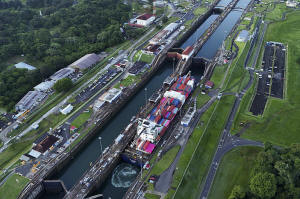Panama, familiar with US intervention, bristles at Trump's comments on
canal
 Send a link to a friend
Send a link to a friend
 [January 21, 2025]
By JUAN ZAMORANO [January 21, 2025]
By JUAN ZAMORANO
PANAMA CITY (AP) — U.S. President Donald Trump’s insistence Monday that
he wants to have the Panama Canal back under U.S. control fed
nationalist sentiment and worry in Panama, home to the critical trade
route and a country familiar with U.S. military intervention.
“American ships are being severely overcharged and not treated fairly in
any way, shape or form, and that includes the United States Navy. And
above all, China is operating the Panama Canal,” Trump said Monday.
In the streets of the capital, some Panamanians saw Trump’s remarks as a
way of applying pressure on Panama for something else he wants: better
control of migration through the Darien Gap. Others recalled the 1989
U.S. invasion of Panama with concern.
Panama President José Raúl Mulino responded forcefully Monday, as he did
after Trump’s initial statement last month that the U.S. should consider
repossessing the canal, saying the canal belongs to his country of 4
million and will remain Panama’s territory.
Luis Barrera, a 52-year-old cab driver, said Panama had fought hard to
get the canal back and has expanded it since taking control.
“I really feel uncomfortable because it’s like when you’re big and you
take a candy from a little kid,” Barrera said.

At a rally in Phoenix in December, Trump said he might try to get the
canal back after it was “foolishly” ceded to Panama. He complained that
shippers were overcharged and that China had taken control of the key
shortcut between the Pacific and Atlantic oceans.
Earlier this month, Trump wouldn’t rule out using military force to take
it back.
The United States built the canal in the early 1900s as it looked for
ways to facilitate the transit of commercial and military vessels
between its coasts. Washington relinquished control of the waterway to
Panama on Dec. 31, 1999, under a treaty signed in 1977 by President
Jimmy Carter.
[to top of second column]
|

A cargo ship traverses the Agua Clara Locks of the Panama Canal in
Colon, Panama, Sept. 2, 2024. (AP Photo/Matias Delacroix, File)

The canal is a point of pride for Panamanians. On Dec. 31, they
celebrated the 25th anniversary of the handover, and days later they
commemorated the deaths of 21 Panamanians who died at the hands of
the U.S. military decades earlier.
On Jan. 9, 1964, students protested in the then-U.S. controlled
canal zone over not being allowed to fly Panama’s flag at a
secondary school there. The protests expanded to general opposition
to the U.S. presence in Panama and U.S. troops got involved. A group
of protesters this year burned an effigy of Trump.
The canal’s administrator, Ricaurte Vásquez, said this month that
China is not in control of the canal and that all nations are
treated equally under a neutrality treaty.
He said Chinese companies operating in the ports on either end of
the canal were part of a Hong Kong consortium that won a bidding
process in 1997. He added that U.S. and Taiwanese companies operate
other ports along the canal as well.
Omayra Avendaño, who works in real estate, said Trump’s threat
should be taken seriously.
“We should be worried,” she said. “We don’t have an army and he’s
said he would use force.”
On Dec. 20, 1989, the U.S. military invaded Panama to remove
dictator Manuel Noriega. Some 27,000 troops were tasked by
then-President George H.W. Bush with capturing Noriega, protecting
the lives of Americans living in Panama and restoring democracy to
the country that a decade later would take over control of the
Panama Canal.
Avendaño said she was 11 years old the last time the U.S. invaded
her country and hoped Panama’s current government would seek
international support to head off Trump’s designs on the canal.
“I remember the disaster that it was,” she said.
All contents © copyright 2025 Associated Press. All rights reserved |